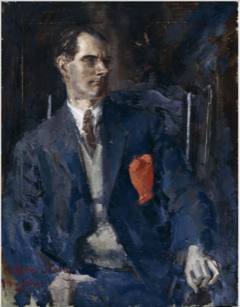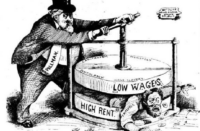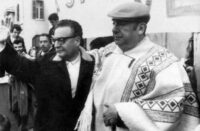Sean O’Casey’s dark comedy Cock-a-Doodle Dandy (1949) is set in Ireland about 1940 and is rarely performed.
Witchcraft is haunting the village of Nyadnanave ever since Marthraun’s daughter by his first wife, Loreleen, arrived from London. A rooster causes commotion and embodies indomitable joie de vivre and rebelliousness. The setting in the backwoods suggests a provincial Irish state. A theocracy overlays and dominates all action.
The play takes place outside Michael Marthraun’s house. Eerie whispers are abroad, holy pictures are inverted, so Marthraun—small farmer, local politician, and owner of a lucrative bog—tells Mahan, the owner of a fleet of lorries carrying turf from bog to town.
Loreleen is a well-read young woman who has brought with her books that have been banned by the state. She, like other life-affirming characters in this play, is colourfully dressed, like a rooster. Loreleen has a disquieting effect on the other women in the house.
A love of life and an advocacy of a better life go together. Two young workers, wearing colourful scarves, demand more pay and threaten to strike. At the same time they also show themselves open to Loreleen’s charms.
Mahan and Marthraun both belong to the (Catholic-Masonic) Order of Knights of St Columbanus, are friends with the old arch-Catholic Shanaar (Irish seanfhear, old man), Father Domineer, and the Sergeant, all of whom still believe in witches. In the constellation of characters, Catholicism, the state and business all belong together.
When a rooster gets lost in the house, chaos ensues. The rooster, after which the play is titled, is highly symbolic: it embodies something menacingly supernatural. Secondly, it symbolises positive vitality and sensuality, courage, and rebelliousness.
The messenger Robin Adair, also colourfully dressed, is, along with Loreleen, the antagonist. Both are completely realistic and immune to superstition. Slowly the characters group around the poles of the humane and life-affirming and the inhumane and life-denying.
Act 2 opens with Marion and Lorna laughing at Mahan and Marthraun and becoming increasingly realistic, less superstitious.
A delivery man appears with a new top hat for Marthraun, to replace the one damaged in the cock hunt, but it has already been shot through in transit by the sergeant—he, like the local politician, is part of the establishment. This is not only indicated by his bizarre behaviour: he also speaks as pompously, and wrongly, as Mahan and Marthraun. They all use words that sound “educated” to them but use them incorrectly, because of their lack of book-reading.
The sergeant tells us that when he shot at the cock it turned into a top hat. Mahan and Marthraun, as well as the sergeant, are beside themselves with fear, and blame the unmanageable women.
The whiskey Mahan and Marthraun brought to seal their business negotiations with turns into a fiery monster whenever they approach. When other male, church-going visitors show interest in the liquor, this eerie metamorphosis also frightens them off.
Loreleen, Marion and Lorna appear in colourful costumes, dressed as “gypsies,” rebelliously undermining the Catholic notion of proper women’s dress.
At this moment a golden light appears and has a strange effect, dazing the men. The women have changed so much by now that they can see nothing unusual in either feathered fowl, top hat, or whiskey. They have a glass of whiskey, and ask the men to dance.
At this wonderful moment the men forget their haggling and their fear of witchcraft. Mahan and Marthraun are able to reach a business agreement, and even the top hat loses its menace. As they all dance together, horns appear on the women’s heads.
Suddenly Father Domineer appears, and all but Loreleen and Robin fall to their knees. Domineer threatens the group gathered before him because of their dancing, and he rages that pagan poison is coming into the country through films, books and plays that weaken the priests’ power over souls.
Domineer rebukes the women for their misbehaviour, and the men submit to him. Mahan, however, is not quite so submissive and refuses to obey Domineer’s order to dismiss his best driver, Jack, because he lives with a woman outside marriage.
Domineer kills Jack. The sergeant immediately exonerates the killer. Robin “comments” on the murder. No-one stands up for Jack; he is isolated in the community.
The house is shaken by thunder and lightning, and all but Loreleen run for safety. Domineer emerges. He vows to destroy Loreleen’s books.
The cock dances during this confrontation between all the protagonists, and accordion music is heard. Mahan and Marthraun resume their endless haggling, Marthraun’s attitude towards his wife reverts to what it was. Lorna, however, is no longer the same. Common sense and a new self-confidence have taken hold of her.
Shanaar and the two workers bring Loreleen, who was attacked by an incited mob. There is nothing to indicate that these workers defended Loreleen, to whose sensuality and beauty they had earlier been attracted. They have regressed, failed to realise their potential. Very different behaviour might have been expected from Jack, the driver whom Domineer killed, the more conscious proletarian over whom the priest had no control.
The pursuit by the villagers of Loreleen and the rooster, as well as the attempted intimidation of all the women here, allows for parallels not only with the Middle Ages but also with McCarthyism, which was emerging in the late 1940s.
All hope seems lost. Superstition and misanthropy have prevailed for the time being. But the rooster remains free. Although the forces of humanity leave the stage, he remains, part of eternally renewing nature, expecting to cause turmoil again in future. Loreleen, Lorna, Marion and Robin depart. However, they too may return, only to cause upheaval once more.






